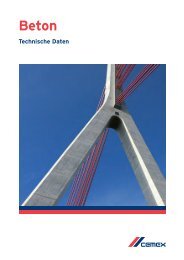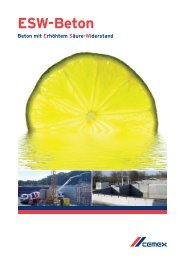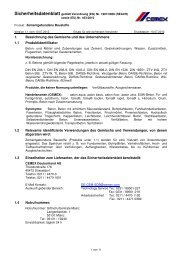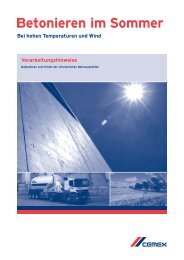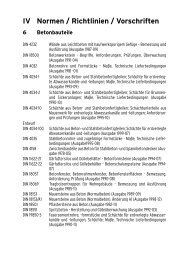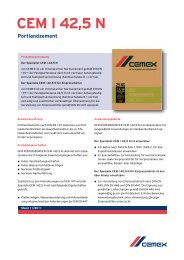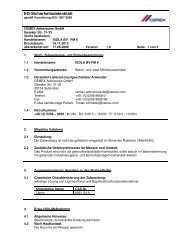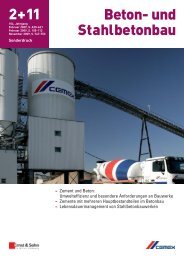building a better future - Cemex
building a better future - Cemex
building a better future - Cemex
Create successful ePaper yourself
Turn your PDF publications into a flip-book with our unique Google optimized e-Paper software.
about<br />
this report<br />
Reporting history and cycle<br />
CEMEX began publishing annual environmental, health, and<br />
safety reports in 1996, and then in 2003 published its first<br />
Sustainable Development Report. The company has been<br />
engaged in annual sustainability reporting since then and<br />
published its most recent report in April 2010. This, the company’s<br />
full 2011 Sustainable Development Report, is our ninth<br />
such report that covers the broad range of our environmental,<br />
social, and governance issues and performance.<br />
We applied the Global Reporting Initiative (GRI) G3 Sustainability<br />
Reporting Guidelines to produce the report,<br />
which meets an application level of A+ for the fourth<br />
consecutive year.<br />
Boundary and reporting period<br />
This report covers our global cement, ready-mix concrete, and<br />
aggregates operations, presenting our sustainability performance,<br />
progress, achievements, and challenges for the 2011<br />
calendar year, which is also the company’s fiscal year. We have<br />
emphasized those issues identified as high-priority through<br />
both our materiality analysis and our sustainable development<br />
strategic planning process, as reflected in the seven priority<br />
areas of our Sustainable Development Model. For more<br />
information as well as updates throughout the year, please<br />
visit the Sustainable Development section of our website.<br />
Unless otherwise indicated, the information provided in<br />
this report is for the company as a whole. We have included<br />
information for the operations in which we have financial<br />
and operative control. If a plant is sold, its information is no<br />
longer included in our data or considered in our targets. If we<br />
have restated certain data sets from previous years because of<br />
improvements to our data-collection systems or changes to our<br />
business, each case is clearly marked. All monetary amounts are<br />
reported in US dollars. All references to “tons” are to metric tons.<br />
The information for this report came from several sources,<br />
including internal management systems and performance<br />
databases and our Sustainable Development Report Survey, a<br />
questionnaire sent to all countries where we have operations.<br />
Data from this survey is then aggregated. This approach has<br />
enabled us to report progress on our key performance indicators<br />
for the company as a whole.<br />
We aim to improve the transparency and completeness of<br />
each report that we produce while streamlining our processes<br />
and the way in which we provide information. We include a<br />
statement from PricewaterhouseCoopers, which verified our<br />
data on greenhouse gas emissions; atmospheric emissions;<br />
alternative fossil and biomass fuels rates; environmental<br />
incidents; and safety indicators for our cement, ready-mix, and<br />
aggregates operations.<br />
In addition, we engaged with our Sustainable Development<br />
Reporting Advisory Panel, which provides feedback on our<br />
reporting.<br />
Data measurement techniques<br />
We employ the following protocols and techniques for measuring<br />
the key performance indicator (KPI) data that we report:<br />
• CO2 Emissions. CEMEX reports absolute and specific CO2<br />
emissions following the CSI Cement Protocol CO2 Accounting<br />
and Reporting Standard for the Cement guidelines and<br />
spreadsheet. As defined in the protocol, it considers direct<br />
emissions excluding CO2 emissions from biomass fuels<br />
and purchased electricity. All historical information from<br />
baseline to current year is calculated under these procedures<br />
to reflect appropriate trends and allow year-to-year<br />
comparison analysis.<br />
• Dust, NOx and SOx emissions. Absolute and specific figures<br />
are calculated based on kilns emissions measurements<br />
taken from Continuous Emissions Monitoring Systems (in<br />
those sites where kilns are equipped with such technology)<br />
or spot analysis. These methods fully comply with the<br />
CSI Guidelines for Emissions Monitoring and Reporting. All<br />
information is reported to CEMEX databases, processed,<br />
calculated, and validated to provide a final group value.<br />
• Energy. Fuel consumption indicators are reported to<br />
internal CEMEX databases in which “conventional”, “alternative”,<br />
and “biomass fuels” are classified according to<br />
the CSI Cement CO2 protocol spreadsheet. Heat values are<br />
obtained from on-site analysis (where applicable), values<br />
provided by suppliers or standards from the CSI Guidelines<br />
for the Selection and Use of Fuels and Raw Materials in<br />
the Cement Manufacturing Process.<br />
• Clinker factor and alternative fuels. All material consumption<br />
is reported to internal CEMEX databases in which<br />
“alternative materials” are defined following the standards<br />
from the CSI Guidelines for the Selection and Use of Fuels<br />
and Raw Materials in the Cement Manufacturing Process.<br />
The “clinker/cement factor” is calculated using the procedures<br />
from the CSI Cement CO2 protocol spreadsheet with<br />
information obtained from the databases.<br />
• Safety. An internal CEMEX safety database collects all<br />
related safety information from each site and automatically<br />
provides the appropriate information to calculate the<br />
indicators. The database is configured using the WBCSD /<br />
CSI definitions.<br />
Deviation from protocols<br />
We have adhered to the GRI Protocols where applicable and<br />
feasible. As our data-collection systems are still in development,<br />
however, there are instances in which we have not applied GRI<br />
protocols. In such cases the data we have is the best manner in<br />
which we can currently communicate our performance.<br />
United Nations Global Compact Communication on Progress<br />
This report constitutes our Communication on Progress toward<br />
the commitments of the United Nations Global Compact<br />
(UNGC). As a signatory to the Global Compact, we work to<br />
align our company’s operations and strategies with its ten<br />
principles. We are also committed to helping the world meet<br />
the targets of the Kyoto Protocol and Millennium Development<br />
Goals.<br />
The GRI index is cross referenced to the UNGC principles; it<br />
can be found on our website and is available for download at<br />
www.cemex.com/sustainability<br />
We welcome your feedback on our sustainability reporting<br />
and performance. Please send your comments and suggestions<br />
to sd@cemex.com, or write to us at:<br />
CEMEX, S.A.B. de C.V.<br />
Corporate Communications and Public Affairs<br />
Av. Ricardo Margáin Zozaya 325<br />
San Pedro Garza García, NL<br />
CP 66265 Mexico<br />
Tel: +52 (81) 8888-8888<br />
< previous 57 next>



